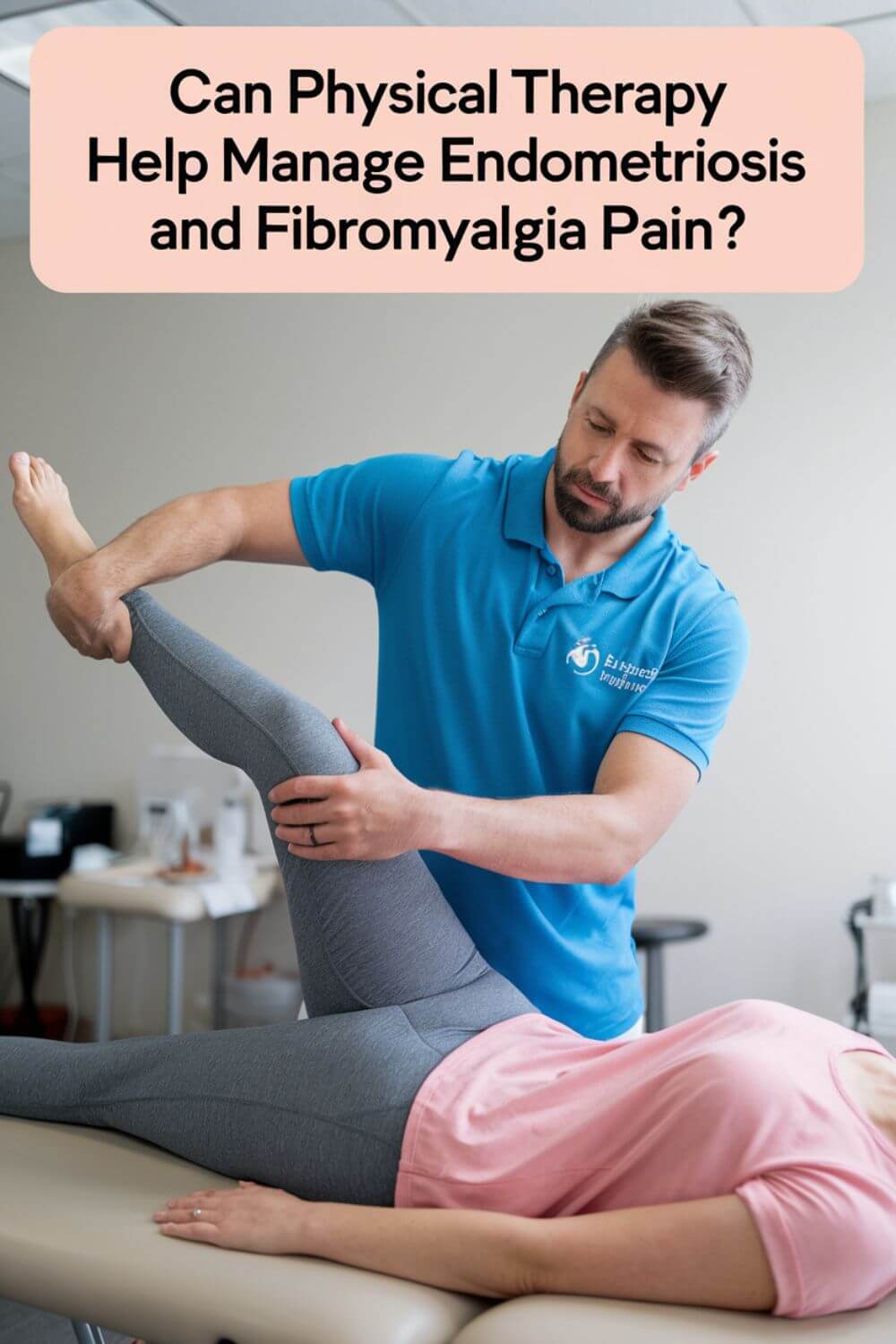Can Physical Therapy Help Manage Endometriosis and Fibromyalgia Pain?
If you’re living with endometriosis or fibromyalgia, you may be wondering if physical therapy can help alleviate your pain and improve your quality of life. Both conditions can cause significant discomfort and impact daily activities, but physical therapy offers potential benefits for managing symptoms and enhancing overall well-being.
Physical therapy plays a crucial role in managing endometriosis pain by focusing on the pelvic floor. Through pelvic floor physical therapy, individuals with endometriosis can retrain their pelvic muscles to relax and coordinate contractions, reducing spasms and alleviating symptoms such as pelvic pain, back pain, painful urination, and painful bowel movements. Additionally, pelvic floor physical therapy can help address abdominal bloating and painful sex, which are common challenges faced by those with endometriosis.
For individuals with fibromyalgia, physical therapy aims to relieve symptoms such as pain, stiffness, and fatigue, while improving muscle flexibility and range of motion. Through exercises, stretching, strengthening programs, deep tissue massage, and hydrotherapy with moist heat or cold packs, physical therapists work closely with individuals to design a fibromyalgia-specific treatment program. This program takes into account individual needs and preferences, ensuring a holistic approach to managing fibromyalgia pain.
If you’re considering physical therapy for endometriosis or fibromyalgia, it’s important to consult with a licensed physical therapist who has experience in treating these conditions. They can provide personalized guidance and expert knowledge to develop a comprehensive pain management plan that incorporates physical therapy techniques.
Key points we are going to discuss here are going to be:
- Pelvic floor physical therapy can help manage endometriosis pain by retraining pelvic muscles and reducing spasms.
- Physical therapy for fibromyalgia focuses on relieving pain, stiffness, and fatigue, improving muscle flexibility and range of motion.
- Individualized treatment programs and at-home exercises are essential for managing both conditions.
- Consulting with a licensed physical therapist experienced in treating endometriosis and fibromyalgia is crucial for effective pain management.
- Physical therapy can play a significant role in improving the quality of life for individuals with endometriosis and fibromyalgia.
- Understanding Endometriosis and Fibromyalgia
- The Benefits of Pelvic Floor Physical Therapy for Endometriosis Pain
- Techniques for Relieving Endometriosis Pain Through Physical Therapy
- Addressing Abdominal Bloating and Painful Sex with Physical Therapy
- Understanding Fibromyalgia and Its Impact on Daily Life
- Relieving Fibromyalgia Pain Through Physical Therapy
- Designing a Fibromyalgia-Specific Treatment Program
- Techniques and Strategies for Managing Fibromyalgia Pain at Home
- Consulting with a Licensed Physical Therapist for Endometriosis and Fibromyalgia
- Incorporating Physical Therapy into a Comprehensive Pain Management Plan
- Conclusion on Can Physical Therapy Help Manage Endometriosis and Fibromyalgia Pain
- Source Links for Can Physical Therapy Help Manage Endometriosis and Fibromyalgia Pain
Understanding Endometriosis and Fibromyalgia
Before exploring the role of physical therapy in managing endometriosis and fibromyalgia pain, it’s important to understand these conditions and the impact they can have on your daily life. Endometriosis is a chronic condition where the tissue that lines the uterus grows outside of it, causing severe pelvic pain, fertility issues, and other symptoms. Fibromyalgia, on the other hand, is a disorder characterized by widespread musculoskeletal pain, fatigue, sleep disturbances, and cognitive difficulties.
Living with endometriosis can bring about a range of challenges, including painful periods, abdominal bloating, and painful intercourse. These symptoms can significantly impact your quality of life and overall well-being. Fibromyalgia, on the other hand, can make it difficult to perform daily tasks, engage in physical activities, and enjoy a restful sleep. Both conditions can cause significant pain and discomfort, leading individuals to search for effective pain management strategies.
Physical therapy can play a crucial role in managing the pain associated with endometriosis and fibromyalgia. By employing specialized techniques, physical therapists can help alleviate symptoms, improve muscle flexibility and coordination, and enhance overall well-being. In the next sections, we will delve into the benefits of physical therapy for each condition and explore specific treatment approaches to help individuals find relief and regain control of their lives.

Understanding Endometriosis and Fibromyalgia
Endometriosis is a chronic condition where the tissue that lines the uterus grows outside of it, causing severe pelvic pain, fertility issues, and other symptoms. Fibromyalgia, on the other hand, is a disorder characterized by widespread musculoskeletal pain, fatigue, sleep disturbances, and cognitive difficulties.
Living with endometriosis can bring about a range of challenges, including painful periods, abdominal bloating, and painful intercourse. These symptoms can significantly impact your quality of life and overall well-being. Fibromyalgia, on the other hand, can make it difficult to perform daily tasks, engage in physical activities, and enjoy a restful sleep. Both conditions can cause significant pain and discomfort, leading individuals to search for effective pain management strategies.
Physical therapy can play a crucial role in managing the pain associated with endometriosis and fibromyalgia. By employing specialized techniques, physical therapists can help alleviate symptoms, improve muscle flexibility and coordination, and enhance overall well-being. In the next sections, we will delve into the benefits of physical therapy for each condition and explore specific treatment approaches to help individuals find relief and regain control of their lives.
| Endometriosis Symptoms | Fibromyalgia Symptoms |
|---|---|
| Pelvic pain | Musculoskeletal pain |
| Abdominal bloating | Fatigue |
| Painful urination | Sleep disturbances |
| Painful bowel movements | Cognitive difficulties |
| Painful intercourse |

The Benefits of Pelvic Floor Physical Therapy for Endometriosis Pain
Pelvic floor physical therapy has shown promising results in managing endometriosis pain by targeting the pelvic muscles and addressing the specific symptoms associated with this condition. By retraining the pelvic muscles to relax and coordinate contractions, this specialized form of physical therapy can reduce spasms and improve symptoms such as pelvic pain, back pain, painful urination, and painful bowel movements.
One of the key benefits of pelvic floor physical therapy is its ability to alleviate the pain and discomfort experienced during sexual intercourse. Endometriosis commonly causes painful sex, known as dyspareunia, due to the presence of endometrial tissue outside the uterus. Through targeted exercises and techniques, pelvic floor physical therapy can help individuals with endometriosis manage this symptom and enhance their overall sexual well-being.
In addition to addressing pain and discomfort, pelvic floor physical therapy can also help alleviate abdominal bloating, a common symptom of endometriosis. By focusing on strengthening the pelvic floor muscles and improving overall muscle coordination, this therapy can contribute to reducing bloating and improving digestive function. This can lead to a significant improvement in quality of life for individuals with endometriosis.
| Benefits of Pelvic Floor Physical Therapy for Endometriosis |
|---|
| Reduces pelvic pain |
| Improves back pain |
| Relieves painful urination |
| Alleviates painful bowel movements |
| Addresses painful sex |
| Reduces abdominal bloating |
“Pelvic floor physical therapy has shown promising results in managing endometriosis pain by targeting the pelvic muscles and addressing the specific symptoms associated with this condition.”
When seeking pelvic floor physical therapy for endometriosis pain, it is crucial to consult with a licensed physical therapist who has experience in treating this condition. They can provide personalized guidance and tailor the treatment program to suit individual needs and preferences, ensuring the most effective and beneficial outcomes.
Techniques for Relieving Endometriosis Pain Through Physical Therapy
Physical therapy offers a range of techniques that can help alleviate endometriosis pain and improve your overall well-being. Pelvic floor physical therapy, in particular, has shown promising results in managing endometriosis-related symptoms. This specialized form of therapy focuses on retraining the pelvic muscles to relax and coordinate contractions, reducing spasms and alleviating pelvic pain, back pain, painful urination, and painful bowel movements.
During a pelvic floor physical therapy session, a licensed therapist will work with you to develop a personalized treatment plan tailored to your specific needs. This may include a combination of exercises, stretches, and massage techniques aimed at relieving tension, improving muscle coordination, and reducing pain. By strengthening and conditioning the pelvic muscles, physical therapy can help restore normal function and alleviate the symptoms associated with endometriosis.
In addition to addressing physical discomfort, physical therapy can also help improve other aspects of your life affected by endometriosis. It can help reduce painful sex by addressing underlying muscle tension and assisting in the relaxation of the pelvic floor. Furthermore, physical therapy techniques can also help alleviate abdominal bloating, a common symptom experienced by individuals with endometriosis, by improving circulation and reducing inflammation in the abdominal area.
If you are struggling with endometriosis pain, it is essential to consult with a licensed physical therapist experienced in treating individuals with this condition. They can assess your symptoms, develop a targeted treatment plan, and provide guidance on at-home exercises and self-care strategies to complement your in-person therapy sessions. Remember, physical therapy can be a valuable tool in managing endometriosis pain and improving your overall quality of life.
| Benefits of Physical Therapy for Endometriosis |
|---|
| Reduces pelvic pain and discomfort |
| Improves muscle coordination and flexibility |
| Alleviates back pain and painful urination/bowel movements |
| Helps reduce painful sex |
| Relieves abdominal bloating |

Addressing Abdominal Bloating and Painful Sex with Physical Therapy
In addition to managing pelvic pain, physical therapy can also offer relief from abdominal bloating and painful sex, providing a comprehensive approach to managing endometriosis symptoms. Abdominal bloating is a common symptom experienced by individuals with endometriosis, causing discomfort and affecting daily activities. Through targeted exercises and techniques, physical therapists can help relieve this symptom by improving pelvic muscle coordination and reducing tension in the abdominal area.
Painful sex, known as dyspareunia, is another challenging symptom faced by those with endometriosis. It can have a significant impact on quality of life and intimate relationships. Physical therapy can play a crucial role in addressing painful sex by focusing on pelvic floor muscle relaxation and improving overall pelvic health. By identifying tight or weak muscles, physical therapists can develop personalized treatment plans that incorporate stretching, relaxation techniques, and exercises to relieve pain and discomfort during intercourse.
When it comes to managing and addressing abdominal bloating and painful sex, physical therapy offers a non-invasive and holistic approach that aims to improve the overall well-being of individuals with endometriosis. By working closely with a licensed physical therapist experienced in treating endometriosis, you can receive personalized care that targets your specific symptoms and helps you regain control over your daily life.
It is important to note that every individual is unique, and the effectiveness of physical therapy for managing endometriosis and fibromyalgia may vary. Consulting with a licensed physical therapist who specializes in treating these conditions is crucial for developing a personalized treatment plan that meets your specific needs. Through the guidance and support of an experienced physical therapist, you can improve your symptoms, regain functionality, and enhance your overall quality of life.
| Benefits of Physical Therapy for Endometriosis | Benefits of Physical Therapy for Fibromyalgia |
|---|---|
|
|
Understanding Fibromyalgia and Its Impact on Daily Life
Fibromyalgia is a chronic condition characterized by widespread pain, fatigue, and stiffness that may significantly impact your ability to carry out daily activities. This condition affects millions of people, predominantly women, and can be challenging to manage. Fortunately, physical therapy can play a crucial role in relieving symptoms and improving quality of life for individuals with fibromyalgia.
When it comes to managing fibromyalgia pain, physical therapy focuses on a multidisciplinary approach that targets various aspects of the condition. Physical therapists work closely with individuals to develop a tailored treatment program that addresses their specific needs and preferences. This may involve a combination of exercises, stretching, strengthening programs, deep tissue massage, and hydrotherapy with moist heat or cold packs.

Relieving Fibromyalgia Pain Through Physical Therapy
Physical therapy aims to improve muscle flexibility, range of motion, and overall well-being in individuals with fibromyalgia. It can help reduce pain, stiffness, and fatigue, allowing you to regain functionality and engage in activities that you may have previously avoided due to discomfort. The hands-on approach of physical therapy also provides a safe and supportive environment for individuals to learn strategies for self-management.
Consulting with a licensed physical therapist experienced in treating fibromyalgia is crucial. They can assess your condition, identify specific areas of concern, and design a treatment program tailored to your needs. Physical therapists will guide you through exercises and techniques that you can incorporate into your daily routine, empowering you to take an active role in managing your fibromyalgia pain.
Designing a Fibromyalgia-Specific Treatment Program
A fibromyalgia-specific treatment program is essential for optimal outcomes. Physical therapists take into account individual factors such as pain levels, mobility, and personal goals when designing your program. They also educate you on self-care strategies and provide valuable advice on managing symptoms at home.
By addressing the physical and emotional aspects of fibromyalgia, physical therapy can help you regain control over your life and reduce the impact of this chronic condition. Remember to consult with a licensed physical therapist who specializes in treating fibromyalgia to ensure you receive the most appropriate care and support.
| Benefits of Physical Therapy for Fibromyalgia |
|---|
| Alleviates pain, stiffness, and fatigue |
| Improves muscle flexibility and range of motion |
| Enhances overall well-being and functionality |
| Empowers individuals with self-management strategies |

Relieving Fibromyalgia Pain Through Physical Therapy
Physical therapy can be an effective tool in managing fibromyalgia pain, offering relief from the symptoms that can greatly impact your quality of life. The goal of physical therapy for fibromyalgia is to improve muscle flexibility, range of motion, and overall well-being.
A variety of techniques and approaches are used in physical therapy to address the specific needs of individuals with fibromyalgia. These may include exercises to strengthen muscles, improve posture, and increase endurance. Stretching programs are also commonly employed to reduce stiffness and increase flexibility. Deep tissue massage can help alleviate muscle tension, while hydrotherapy with moist heat or cold packs may provide pain relief.
Physical therapists work closely with individuals with fibromyalgia to design a personalized treatment program that takes into account their unique needs and preferences. They provide guidance on at-home exercises and self-care strategies to help manage pain and improve daily functioning. Consulting with a licensed physical therapist experienced in treating fibromyalgia is crucial in order to receive tailored care and achieve optimal results.
With the help of physical therapy, individuals with fibromyalgia can regain control over their lives and find relief from the debilitating symptoms that often accompany this condition. By implementing a comprehensive treatment plan that includes physical therapy, individuals can experience improved mobility, decreased pain, and enhanced overall well-being.
| Techniques for Relieving Fibromyalgia Pain | Benefits of Physical Therapy for Fibromyalgia |
|---|---|
| Strengthening exercises | Improved muscle flexibility |
| Stretching programs | Increased range of motion |
| Deep tissue massage | Alleviation of muscle tension |
| Hydrotherapy | Pain relief with moist heat or cold packs |
Designing a Fibromyalgia-Specific Treatment Program
Every individual with fibromyalgia is unique, which is why it’s crucial to work closely with a physical therapist to develop a personalized treatment program that addresses your specific pain management goals. Physical therapy for fibromyalgia focuses on relieving symptoms of pain, stiffness, and fatigue, while improving muscle flexibility and range of motion.
During your initial consultation with a licensed physical therapist experienced in treating fibromyalgia, they will assess your condition and discuss your symptoms, limitations, and goals. This assessment will help the physical therapist design a customized treatment program tailored to your needs.
The treatment program may involve a combination of exercises, stretching routines, and strengthening programs to help improve muscle function and reduce pain. Physical therapists may also incorporate deep tissue massage techniques to alleviate muscle tension and promote relaxation. Additionally, hydrotherapy using moist heat or cold packs can provide relief and reduce inflammation in affected areas.

Sample Fibromyalgia-Specific Treatment Program
| Exercise | Duration/Frequency |
|---|---|
| Gentle stretching | Daily, 10-15 minutes |
| Low-impact aerobic exercises (e.g., walking, swimming) | 3 times a week, 20-30 minutes |
| Strength training using light weights or resistance bands | 2-3 times a week, 15-20 minutes |
| Deep tissue massage | Once a week, 60 minutes |
Your physical therapist will guide you through each exercise and provide instructions on proper form and technique. They will monitor your progress and make any necessary adjustments to ensure the program remains effective and safe.
Additionally, your physical therapist will provide guidance on incorporating physical therapy techniques into your daily routine. This may include recommendations for at-home exercises, self-care strategies, relaxation techniques, and lifestyle modifications that can help manage fibromyalgia symptoms.
If you are living with fibromyalgia, remember that you don’t have to face it alone. A licensed physical therapist can be an invaluable resource in helping you develop a personalized treatment program that addresses your specific needs and goals. With their guidance and support, you can regain control over your pain and improve your overall well-being.
Techniques and Strategies for Managing Fibromyalgia Pain at Home
In addition to in-clinic sessions, your physical therapist can provide you with exercises and self-care strategies that you can practice at home to complement your in-person treatment. These techniques and strategies are designed to help you manage your fibromyalgia pain and improve your overall well-being. By incorporating these practices into your daily routine, you can experience relief and enhance your quality of life.
1. Home Exercise Program: Your physical therapist will create a customized home exercise program tailored to your specific needs. This may include gentle stretching exercises to improve muscle flexibility, strength training exercises to improve muscle tone, and low-impact aerobic exercises to increase endurance. By consistently following your prescribed exercise program, you can strengthen your muscles, reduce pain, and improve your energy levels.
2. Self-Care Strategies: Your physical therapist will provide you with self-care strategies that you can implement at home to manage fibromyalgia pain. This may include techniques such as practicing deep breathing exercises to promote relaxation, using heat or cold packs to alleviate pain and stiffness, and adopting stress management techniques to reduce anxiety and improve sleep quality. These self-care strategies can help you manage flare-ups and promote overall well-being.
3. Lifestyle Modifications:
Your physical therapist may recommend certain lifestyle modifications to help manage your fibromyalgia pain. This may include maintaining a healthy and balanced diet, ensuring adequate rest and sleep, managing stress levels, and incorporating relaxation techniques into your daily routine. By making these lifestyle changes, you can support your physical therapy treatment and optimize your pain management.
By working closely with your physical therapist and diligently practicing these techniques and strategies at home, you can take an active role in managing your fibromyalgia pain and improving your overall quality of life. Remember to consult with a licensed physical therapist who has experience in treating fibromyalgia to ensure you receive the most effective and personalized care.

Consulting with a Licensed Physical Therapist for Endometriosis and Fibromyalgia
When seeking physical therapy for managing endometriosis or fibromyalgia pain, it’s crucial to find a qualified and experienced physical therapist who can provide the specialized care you need. Physical therapists with expertise in treating these conditions can tailor a treatment plan to address your specific symptoms and challenges.
A licensed physical therapist will conduct a thorough evaluation to assess your condition and develop a personalized treatment approach. They will take into account factors such as the severity of your pain, your range of motion, muscle strength, and any other relevant medical history. This individualized approach ensures that your treatment plan is tailored to your unique needs and goals.
Throughout the treatment process, your physical therapist will guide you through exercises and techniques that target your specific symptoms. They may utilize a combination of manual therapy, therapeutic exercise, and other modalities to help manage your pain and improve your overall function. They will also provide education and support to help you incorporate physical therapy techniques into your daily routine for optimal results.
Benefits of Consulting with a Licensed Physical Therapist
- Specialized care: A licensed physical therapist experienced in treating endometriosis and fibromyalgia understands the unique challenges associated with these conditions and can design a treatment plan that addresses your specific needs.
- Personalized approach: Physical therapists take a patient-centered approach, tailoring treatment plans to each individual’s goals and abilities.
- Pain management strategies: Physical therapy can help reduce pain, improve function, and enhance overall quality of life for individuals with endometriosis and fibromyalgia.
- Guidance for at-home exercises: Your physical therapist will provide guidance on exercises and self-care strategies that you can continue at home, empowering you to take an active role in managing your condition.
By consulting with a licensed physical therapist who specializes in treating endometriosis and fibromyalgia, you can gain access to a wide range of techniques and strategies to manage your pain and improve your overall well-being. Working collaboratively with a physical therapist can help you navigate the challenges of these conditions and find relief through targeted and customized physical therapy interventions.
| Benefits of Consulting with a Licensed Physical Therapist |
|---|
| Specialized care |
| Personalized approach |
| Pain management strategies |
| Guidance for at-home exercises |
Incorporating Physical Therapy into a Comprehensive Pain Management Plan
Physical therapy can play a crucial role in a comprehensive pain management plan for individuals with endometriosis and fibromyalgia, providing long-term relief and improved quality of life. By addressing the unique challenges and symptoms associated with these conditions, physical therapy offers targeted treatment strategies to alleviate pain, manage symptoms, and enhance overall well-being.
Pelvic Floor Physical Therapy for Endometriosis Pain
For individuals with endometriosis, pelvic floor physical therapy is a valuable treatment approach. This specialized therapy focuses on retraining the pelvic muscles to relax and coordinate contractions, reducing spasms and improving symptoms such as pelvic pain, back pain, painful urination, and painful bowel movements. Additionally, pelvic floor physical therapy can help alleviate abdominal bloating and discomfort, as well as improve sexual function and reduce pain during intercourse.
Fibromyalgia-Specific Treatment Program
When it comes to fibromyalgia, physical therapy aims to relieve symptoms of pain, stiffness, and fatigue, while also improving muscle flexibility and range of motion. A licensed physical therapist experienced in treating fibromyalgia will work closely with individuals to design a personalized treatment program. This may include a combination of exercises, stretching, strengthening programs, deep tissue massage, and hydrotherapy with moist heat or cold packs. The therapist will also provide guidance on incorporating these techniques into daily routines, ensuring individuals can continue their pain management efforts at home.
In conclusion, physical therapy offers valuable benefits for managing endometriosis and fibromyalgia pain. Whether through pelvic floor physical therapy for endometriosis or a fibromyalgia-specific treatment program, physical therapists can play a vital role in improving symptom management and overall quality of life. If you are living with endometriosis or fibromyalgia, consulting with a licensed physical therapist experienced in treating these conditions is essential to develop an individualized treatment plan catered to your unique needs.
| Benefits of Physical Therapy for Endometriosis | Benefits of Physical Therapy for Fibromyalgia |
|---|---|
|
|
Conclusion on Can Physical Therapy Help Manage Endometriosis and Fibromyalgia Pain
Physical therapy can be a valuable tool in managing endometriosis and fibromyalgia pain, offering targeted techniques and approaches to alleviate symptoms and improve overall well-being.
For individuals with endometriosis, pelvic floor physical therapy can play a crucial role in reducing pelvic pain, back pain, and improving painful urination and bowel movements. By retraining pelvic muscles to relax and coordinate contractions, physical therapists can help reduce spasms and improve the daily life of those affected by this condition. Additionally, physical therapy can address common symptoms of endometriosis such as abdominal bloating and painful sex, providing relief and restoring quality of life.
When it comes to fibromyalgia, physical therapy focuses on relieving pain, stiffness, and fatigue, while also improving muscle flexibility and range of motion. Through a combination of tailored exercises, stretching programs, and deep tissue massage, physical therapists can help individuals manage their symptoms and enhance their overall well-being. They work closely with patients to design a fibromyalgia-specific treatment program that suits their unique needs and provide guidance on at-home exercises for continued progress.
To ensure the best outcomes, it is essential to consult with a licensed physical therapist experienced in treating both endometriosis and fibromyalgia. These professionals have the knowledge and expertise to create individualized treatment plans and adapt techniques as needed. By incorporating physical therapy into a comprehensive pain management plan, individuals with endometriosis and fibromyalgia can find relief and improve their quality of life.


About Me
Hi, I’m Lucjan! The reason why I decided to create this blog was my beautiful wife, who experienced a lot of pain in life, but also the lack of information about endometriosis and fibromyalgia for men…
